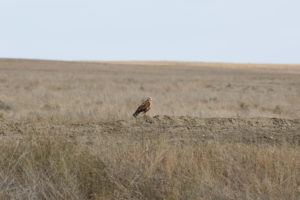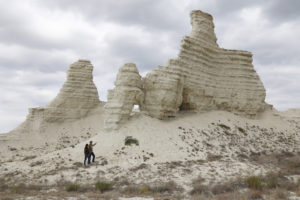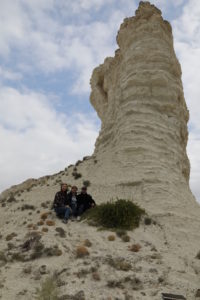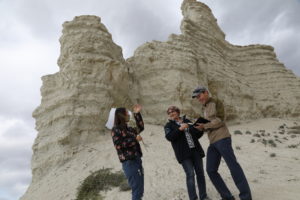One of the functions of the Department of Safety and Environmental Protection, as the name implies, is environmental protection. But what does this mean in practice for a construction company? After all, Ariadne does not have production facilities with sources of air pollution or water bodies, the mechanisms are certified and engine exhausts are tested for MPC of pollutants. Construction waste is disposed of in full accordance with the practice of a strict customer – Tengizchevroil LLP.
“Of course, environmental protection is an integral aspect of our activities,” agrees Natalia Viktorovna Latfulina, head of the department.
– Right now, by the way, we, together with the company “Econormativ”, are developing a project on the maximum permissible standards. And this project, in particular, prescribes what kind of flora we have here, in Tengiz, what kind of fauna, birds, fish, water resources, etc. Yes, we do not have any sources of intensive pollution, but this does not relieve us of responsibility for the ecological state of both the facilities where we work and the nature around us in general. And in order to protect nature, you need to know it. In order to protect the environment competently and effectively.
Ariadne’s production sites are in the heart of the oil Tengiz. Beyond the contours of the TCO oil and gas complex and related facilities is the horizon, the plain to the ends of the earth at all 360 degrees. The Caspian steppe with sparse vegetation, the landscape is completely monotonous.
But this is only at first glance. The winds walking through the expanses blow through the terrain from all sides, the air here is good. Observation stations located along the perimeter of the Tengiz field confirm this with long-term monitoring data. And if you look further? After all, harmful substances, if they do get into the atmosphere, can settle at a considerable distance from the source.


On September 27, for the first time in their practice, a group of specialists from the Department of Safety and Environmental Protection left for an environmental study of the area at a fairly long distance – about a hundred kilometers from the company’s location.
“We decided to visit one of the remarkable corners of the Caspian lowland – the Akkergeshin chalk plateau,” Yerbol Akmurzin, an environmental engineer, clarified the purpose of the trip. – This, as we were told, is a place with an uncharacteristic landscape for this region – the border of the prehistoric shift of the earth’s crust with the exposure of calcareous layers of the Mesozoic and Jurassic periods. There, the soil is different – chalk deposits – and, of course, the vegetation is special. We decided it was worth looking and exploring.
… The path to the chalk plateau is not close. It is located forty kilometers northeast of the city of Kulsary. After an hour of driving along a broken highway – a few kilometers along the steppe track up the gentle slope of the hill. We drive carefully: quite unexpectedly, the plane of the steppe covered with wormwood may turn out to be the edge of the cliff – the border of the plateau. Therefore, no yaws – only on a well-worn track!


And here – right below us is a ridge of bizarre snow-white rocks – Akkergeshin. (It is worth noting that the name of this plateau, fixed on all geographical maps, is untranslatable. Most likely, it is distorted and goes back to the Kazakh “ak kogyrshin” – white dove). White natural sculptures on this fracture of the earth’s crust are creations of wind and water – from rain and snow – erosion of loose chalk and calcareous deposits. The entire Caspian lowland is the bottom of the former huge Khvalyn (Khazar) Sea, which disappeared hundreds of thousands of years ago in the course of turbulent geological processes. Extensive calcareous formations are traces of prehistoric life in warm sea bays, all of them are formed by the remains of diverse living organisms.
“Dove”, however, among the rocks, could not be found, but there is a giant Elephant, a formidable three-headed Serpent Gorynych (or Three Heroes, or Three Sisters – who likes what name), the Sleeping Camel, the Finger of Poseidon … The names are unofficial, they were invented by local historians back in Soviet times, but very accurate in their imagery.


Of course, the first acquaintance is with the Elephant! The giant sculpture is notable for the fact that water and wind made a through hole in it, and it formed the configuration of this chalk rock: the “trunk”, the massive front “legs”, the characteristic silhouette of the “head”. Moreover, on the “back” of an elephant frozen for centuries, like a turret for a rider – such a familiar image, imprinted in the mind of Indian fairy tales from childhood! However, a feeling of sadness is mixed with delight: a second hole has already appeared in the rock, a few years ago it was not, and it is clear that over the years you will no longer see the Elephant here …
– We talk a lot about environmental protection, about the protection of water resources. We say that it is necessary to protect nature, because this is the basis of the foundations, – Natalia Viktorovna does not restrain her emotions. – And today we went to the chalk plateau. This is our first trip, and I would like to share my impressions. I have been working in Tengiz for twelve years, but here I got acquainted with such places for the first time and for the first time, discovering that, in addition to work, in addition to the production site, there are places on our steppe plain that are worth seeing, which must be protected, because thousands and millions of years of processes that took place on our Earth are captured here. I have a whole bunch of impressions and associations after what I saw. Everything is beautiful, everything is magnificent! And I want us, people, to protect the environment not only in words, but in concrete deeds.
But, in addition to emotions, the employees of the department also have work. Rock samples are collected, plants are photographed. It was possible to capture eagles on film, although the owners of the blue expanse do not allow close to them. The “luggage” brought from this mini-expedition will be carefully studied and systematized and will replenish the developed documents on environmental activities with data.


Moldir Esen became interested in plants. Many of those that grow here, she sees for the first time. The young specialist is very pleased with her discoveries:
– I graduated from the university with a degree in Life Safety and Environmental Protection The university studied many species of plants and fauna only from textbooks. But to see everything with my own eyes in such a beautiful corner of our area is a first time for me. There are many varieties of plants here. We saw foxes, hares, large and beautiful eagles on the way … Seeing all this, you understand in your heart that it is our duty to protect the environment.
-Exactly! – supports the enthusiastic girl N. Latfulin. – When we first came here, we discovered that the nature around us, it turns out, is very rich! At least, the plant world is diverse. There are a lot of plants, and plants that probably not many people know about. Here the birds sing – a lot of birds! After all, we have a lot spelled out and there is an analysis of how well we work, protecting the environment from man-made pollution. All this is good. But it is necessary to see it live in order to measure our work not only with the amount of funds that our company directs to environmental work, but also with the real well-being of nature around us!
… Akkergeshin was left behind. The white dove lives its natural life, just like us, humans, experiencing a series of seasons – autumn, winter, spring, summer … Only he has already done it an immeasurably huge number of times. But on the slopes of white rocks, hedgehogs with fleshy “needles” instead of leaves still huddle in flocks, shrubs and steppe cereals scurry fervently at the foot, swifts and larks scurry fervently between the peaks, and eagles soar majestically high above the white figures. He lives, gray-haired Akkergeshin.
And along the lowland between the rocks, a white ribbon stretches the road, which was paved here by the lord of nature – man …
On the way back, we also visited the highest hill of the Caspian lowland – Mount Iman-Kara, examined on its four-hundred-meter peak the Saka burial grounds dating back to the IX – XI centuries, as well as a man-made cave punched in the belly of the mountain by the famous Nobel brothers at the dawn of the 20th century.
But this, as they say, is a completely different story …